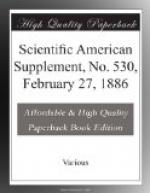It is usual in this country to give a short preliminary boil to the cloth before it is brought in contact with the alkali, the object being to well scour the cloth from the loose impurities present in the raw fiber and also the added sizing materials. In the new process the waste or spent alkaline liquors of the succeeding process are employed, with the result that the bleaching proper is much facilitated. The economy effected by this change is considerable, but in the next operation, that of saponification, the new process differs even more widely from those generally in use. In England, “market” or “white” bleaching requires a number of operations. There is first the alkaline treatment divided into the two stages or processes of lime stewing and bowking in soda-ash, which only imperfectly breaks down the motes. There is consequently a second round given to the goods, consisting of a bowk in soda-ash, followed by the second and usually final chemicking. There is, therefore, much handling of the cloth, with the consequent increase of time and therefore expense.
Now, in the saponification process, the Mather-Thompson Company claim to have achieved a complete triumph. They use a “steamer keir,” the invention of Mr. Mather. This keir is so constructed that it will allow of two wire wagons being run in and the door securely fastened. At the top of the keir is fixed a mechanical appliance for steaming the cloth. The steamer keir process consists essentially in:
1. The application of the alkali in solution and in its most effective form, viz., as caustic alkali, to each portion of fiber in such quantity as to produce the complete result upon that portion.
2. The immediate and sustained action of heat in the most effective form of steam.
Before the cloth is run into the steamer keir on the wire wagons, it is saturated with about twice its weight of a dilute solution of caustic soda (2 deg. to 4 deg. Twaddell = 0.5 to 1% Na_{2}O) at a boiling-temperature, when in the steamer keir it is exposed to an atmosphere of steam at four pounds pressure for five hours. This part of the process is entirely new. The advantage of using caustic soda alone in the one operation, such as I describe, has been long recognized, but hitherto no one has been able to effect this improvement. It will be observed that the Mather-Thompson process does away entirely with the use of lime and soda-ash in at least two boilings and the accessory souring operation. In the space of the five hours necessary for the steamer keir process the goods are thoroughly bottomed and all the motes removed, no matter what be the texture or weight of the cloth. After the cloth is washed in hot water it is removed from the steamer keir, then follows a rinse in cold water, and the goods are ready for the bleaching process.




